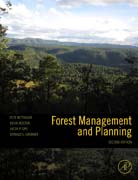
This book provides a focused understanding of contemporary forest management issues through real life examples to engage students. The methodology for the development of quantitatively-derived forest management plans - from gatheringinformation to the implementation of plans at the forest level - are explicitexplained. Emphasis is placed on the development of the traditional commodityproduction forest plans using linear programming, the development of alternative forest plans, and problem resolution in planning.The authors have developed this book based on their personal experience in teaching forest management courses and the review of ten forestry programs (Auburn University, University of Georgia, Iowa State University, Louisiana State University, Northern Arizona University, Ohio State University, Pennsylvania State University, Universityof Florida, Virginia Tech, and Oregon State University). The integration of extended case studies of a variety of scenarios as well as the inclusion of a section on report writing will engage students. Acknowledgement and integrationof various software packages for forest management provide the most useful tools for those studying forest management and distinguish this book from the competition.* Real-life examples illustrated mathematically and graphically* End-of-chapter questions* Modern coverage of the planning and management of US Forest timber production* Instructors Web site with access to geographic databases, solutions and illustrations* Case study analysis* Expansive applications drawn for examples in the western US, the Lake States, the northeastern US, thesouthern US and Canada* Detailed descriptions of models and solution methods for integrating a variety of wildlife habitat constraints
- ISBN: 978-0-12-374304-6
- Editorial: Academic Press
- Encuadernacion: Cartoné
- Páginas: 360
- Fecha Publicación: 20/11/2008
- Nº Volúmenes: 1
- Idioma: Inglés
